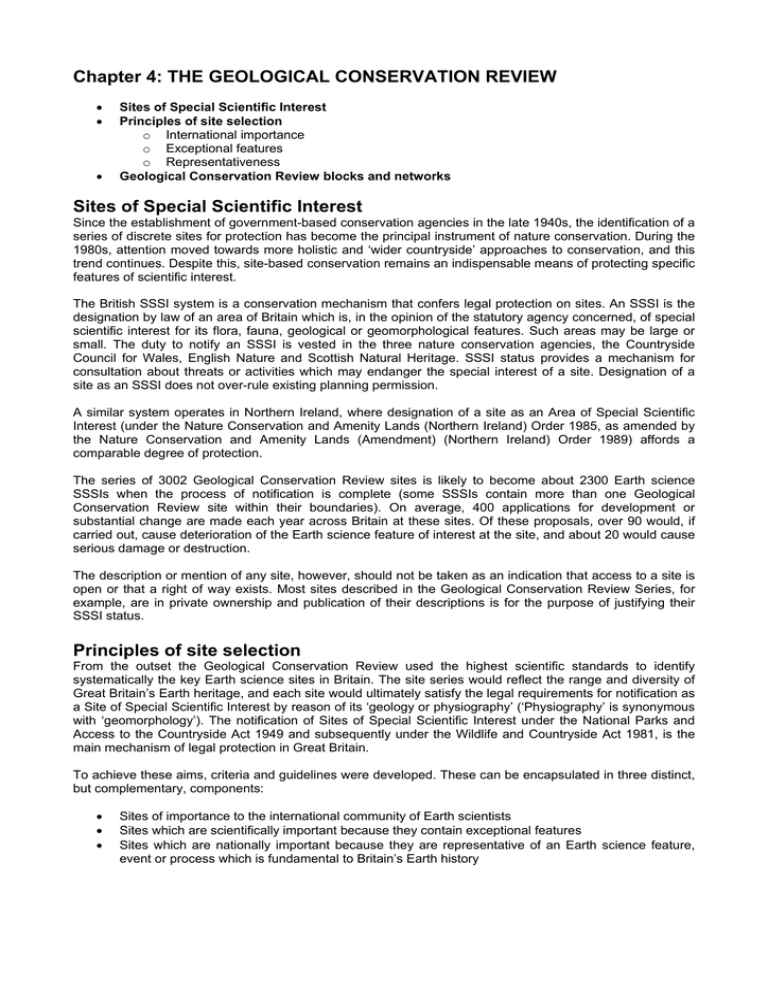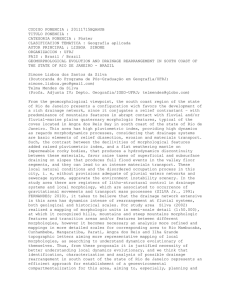
Chapter 4: THE GEOLOGICAL CONSERVATION REVIEW
•
•
•
Sites of Special Scientific Interest
Principles of site selection
o International importance
o Exceptional features
o Representativeness
Geological Conservation Review blocks and networks
Sites of Special Scientific Interest
Since the establishment of government-based conservation agencies in the late 1940s, the identification of a
series of discrete sites for protection has become the principal instrument of nature conservation. During the
1980s, attention moved towards more holistic and ‘wider countryside’ approaches to conservation, and this
trend continues. Despite this, site-based conservation remains an indispensable means of protecting specific
features of scientific interest.
The British SSSI system is a conservation mechanism that confers legal protection on sites. An SSSI is the
designation by law of an area of Britain which is, in the opinion of the statutory agency concerned, of special
scientific interest for its flora, fauna, geological or geomorphological features. Such areas may be large or
small. The duty to notify an SSSI is vested in the three nature conservation agencies, the Countryside
Council for Wales, English Nature and Scottish Natural Heritage. SSSI status provides a mechanism for
consultation about threats or activities which may endanger the special interest of a site. Designation of a
site as an SSSI does not over-rule existing planning permission.
A similar system operates in Northern Ireland, where designation of a site as an Area of Special Scientific
Interest (under the Nature Conservation and Amenity Lands (Northern Ireland) Order 1985, as amended by
the Nature Conservation and Amenity Lands (Amendment) (Northern Ireland) Order 1989) affords a
comparable degree of protection.
The series of 3002 Geological Conservation Review sites is likely to become about 2300 Earth science
SSSIs when the process of notification is complete (some SSSIs contain more than one Geological
Conservation Review site within their boundaries). On average, 400 applications for development or
substantial change are made each year across Britain at these sites. Of these proposals, over 90 would, if
carried out, cause deterioration of the Earth science feature of interest at the site, and about 20 would cause
serious damage or destruction.
The description or mention of any site, however, should not be taken as an indication that access to a site is
open or that a right of way exists. Most sites described in the Geological Conservation Review Series, for
example, are in private ownership and publication of their descriptions is for the purpose of justifying their
SSSI status.
Principles of site selection
From the outset the Geological Conservation Review used the highest scientific standards to identify
systematically the key Earth science sites in Britain. The site series would reflect the range and diversity of
Great Britain’s Earth heritage, and each site would ultimately satisfy the legal requirements for notification as
a Site of Special Scientific Interest by reason of its ‘geology or physiography’ (‘Physiography’ is synonymous
with ‘geomorphology’). The notification of Sites of Special Scientific Interest under the National Parks and
Access to the Countryside Act 1949 and subsequently under the Wildlife and Countryside Act 1981, is the
main mechanism of legal protection in Great Britain.
To achieve these aims, criteria and guidelines were developed. These can be encapsulated in three distinct,
but complementary, components:
•
•
•
Sites of importance to the international community of Earth scientists
Sites which are scientifically important because they contain exceptional features
Sites which are nationally important because they are representative of an Earth science feature,
event or process which is fundamental to Britain’s Earth history
‘Nationally important’ in the context of Geological Conservation Review site selection refers to importance to
Great Britain as a whole, and means that any site chosen for the Geological Conservation Review has been
assessed, wherever possible, against comparable features, where they exist, across the whole of Great
Britain.
Each site selected for the Geological Conservation Review is of at least national importance for Earth
heritage conservation, and many of the sites are of international importance.
International importance
This component for Geological Conservation Review site selection ensures that geological and
geomorphological sites of international importance are included to ensure that our international
responsibilities are met. Five main types of internationally important Geological Conservation Review site
can be recognised.
•
•
•
•
•
Time interval or boundary stratotypes.
Type localities for biozones (rock strata which are characterised by a closely defined fossil content,
usually a fossil species) and chronozones (rock strata formed during the time-span of the relevant
stratotypes).
Internationally significant type localities for particular rock types, mineral or fossil species.
Historically important type localities where rock or time units were first described or characterised, or
where great advances in geological theory were first made (e.g. Hutton’s unconformity at Siccar
Point, Berwickshire).
Important localities where geological or geomorphological phenomena were first recognised and
described, or where a principle or concept was first conceived or demonstrated.
Exceptional features
Many sites have unique, rare or special features. For example, at Rhynie in Scotland, a mineralised peat, in
the form of a siliceous rock called chert of Devonian age, preserves a detailed record of an early land
ecosystem. The exceptional microscopic detail preserved in the Rhynie fossils makes this site quite
exceptional. No other sites are known in Britain to contain such well-preserved material of this age. This
makes Rhynie irreplaceable. The inclusion of exceptional sites ensures that the highlights of British geology
and geomorphology are conserved.
Representativeness
Important though international and exceptional sites are, they cannot provide the basis for a systematic
approach for the selection of sites to cover the essential features of the Earth heritage of Britain. This is
provided by the selection of sites representative of features, events and processes which are fundamental to
our understanding of the geological history of Britain. The starting point of the review was to create subject
‘blocks’ which provided an overall structure for site selection. This ensured that the different themes of Earth
science would receive comparable treatment. The second stage in this approach was to consider the
characteristic features of each block and to select representative sites. Within individual blocks groups of
sites fall into natural groupings based upon geological features or scenarios. These groups are now referred
to as networks and there may be one or more network in any block.
Geological Conservation Review blocks and networks
Many of the Geological Conservation Review blocks correspond to the standard divisions of geological time
or to major events within those periods. They can be grouped into seven broad categories:
•
•
•
•
•
•
•
Stratigraphy (35 blocks)
Palaeontology (16 blocks)
Quaternary geology (16 blocks)
Geomorphology: the landforms and processes which form the current landscape (10 blocks)
Igneous petrology (6 blocks)
Structural and metamorphic geology (10 blocks)
Mineralogy (7 blocks)
The differences between these broad categories required different approaches to Geological Conservation
Review network definition. The network concept is fundamental to the methods of the Geological
Conservation Review, and it is illustrated in some detail in ‘An Introduction to the Geological Conservation
Review’ by describing the actual networks adopted in Geological Conservation Review blocks.

